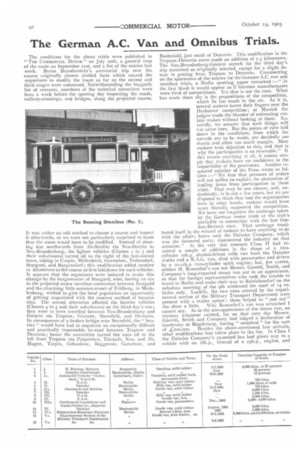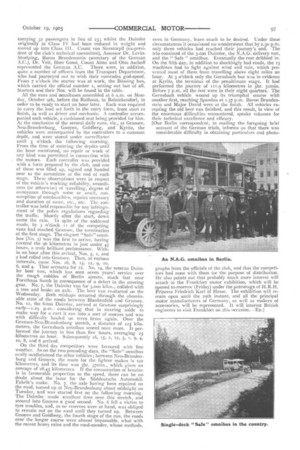The German A.C. Van and Omnibus Trials.
Page 10

Page 11

If you've noticed an error in this article please click here to report it so we can fix it.
The conditions for the above trials were published in
THE COMMERCIAL MOTOR " on July 20th, a general map of the route on September 21st, and a list of the entries last week. Baron Brandenstein's secretarial trip over the course originally chosen yielded facts which caused the organisers to modify the route as far as the second and third stages were concerned. Notwithstanding the beggarly list of entrants, members of the technical committee were busy a week before the opening day inspecting the roads, railway-crossings, and bridges, along the projected course.
It was rather an odd method to choose a course and inspect it afterwards, so we were not particularly surprised to learn that the route would have to be modified-. Instead of steering due northwards from Mt-Strelitz via Neu-Strelitz to Neu-Brandenburg, the lighter vehicles (Classes i to 3 and their sub-classes) turned oft to the right of the last-named town, taking in Carpin, Mollenbeck, Gramelow, Teshendorf, .Stargard, and Bargensforf ; this modification added another 12 kilometres to the course as first laid down foxsuch vehicles. It appears that the organisers were induced to make this change by the burgomaster of Starg-ard, who, having an eye to the projected motor omnibus connection between Stargard and the charming little summer-resort of Feldberg, in Mecklenburg, wished to give the local population an opportunity of getting acquainted with the mooern method of locomotion. The second alteration affected the heavier vehicles (Classes 4 to 5 and their sub-classes) on the third day's run; they were to have travelled between Neu-Brandenburg and -Gnoyen via Treptow-, Glatzow, Sternfield, and Demmin. In consequence of a broken bridge near Sternfeld, the" heavies" would have had to negotiate an exceptionally difficult and practically impassable by-road between Treptow and Demmin ; hence the committee turned the vans off to the left from Treptow via Priipsleben, Tfitzpalz, Nettand AltHagen, TOrpin, Gebunkow, Beg-g,erons, Gutschow, and BushniUhl, just south of Detnmin. This modification in the Treptow-Demmin route made an addition of 2.3 kilometres. The Neu-Brandenburg-Gnoyen stretch for the third day's trip remained as originally selected, except for a slight detour in getting from Treptow to Deminin. Commenting on the sparseness of the entries for the German A.C. van and omnibus trials, a Berlin sporting paper remarked :—" At the first blush it would appear as if German manufacturers were tired of competitions. Yet that is not the case. What has made them shy is the propositions of the competition, which lie too much in the air. As it is, several makers burnt their fingers over the Herkomer competition; al Munich the judges made the blunder of estimating certain makes without looking at them. Naturally, we assume that such things will rot occur here. But the points of view laid down in the conditions, from which the awards are to be made, are decidedly too elastic and allow too much margin. Most makers took objection to this, and that is why the participation is so miserable." It this means anything at all, it means simply ilia": makers have no confidence in the impartiality of the promoters. Another espected member of the Press wrote as follows :--" We fear that pressure of orders wall not suffice to explain the abstention of leading firms from participation in these trials. That may be one reason, and, undoubtedly, is in not a few cases, but we are disposed to think that had the organisation been in other hands, makers would have more liberally supported the competition. We have not forgotten the umbrage taken by the German motor trade at the club's partiality in connection with the last Gordon-Bennett race. That umbrage manifested itself in the refusal of makers to have anything to do with the affair; hence only the Daimler Company, which was the favoured party, represented the industry on that occasion." At the very last moment Class II had received a couple of additions in the shape of a twocylinder toh.p. alcohol-driven milk van from the Daimler works and a N.A.G. van, shod with pneumatics and driven by a io-12h.p, two-cylinder spirit engine ; but, per contra, neither H. Rosenthal's van nor Messrs. Garrett, Smith, and Company's long-expected steam van put in an appearance, so that the foreign representatives who took the trouble to travel to Berlin and make their svay to Reinickendorf on the nebulous morning of the 9th witnessed the start of 14 vehicles only. Luckily, the two vans entered by the experimental section of the Military Transport Department were present with a trailer apiece : these helped to "pad out" the show a little. Why Rosenthal's van was scratched I cannot say. As to the non-appearance of the steam van, no mystery whatever existed, for on that very day Messrs. Garrett, Smith and Company had lodged a declaration of insolvency at Magdeburg, having " smashed " for the sum of £200,000. Besides the above-mentioned late arrivals, other modifications had taken place in the list. In Class I the Daimler Company's 23-seated bus had given way to a vehicle with an iSh.p., instead of a 25h.p., engine, and carrying 32 passengers in lieu of 23; whilst the Daimler originally in Class IV had been reduced in weight and moVed up into Class III. Count von Sierstorpff (ex-president of the club's technical committee), Assessor Dr. LevinStoelping, Baron Brandenstein (secretary of the German A.C.), Dr. Veit, Herr Gossi, Count Alten and Otto Aschoff
represented the German A.G. There were, in addition, quite a number of officers from the Transport Department, who had journeyed out to wish their comrades god-speed. From 7 o'clock the starter was at work, the Bussing bus, which carried the official number 1, setting out last of all. Starters and their Nos. will be found in the table.
All the vans and omnibuses assembled at 6 a.m. on Monday, October 9th, before the Rathaus, in Reinickendorf, in order to be ready to start an hour later. Each was required to carry the load set forth in the entry form, from start to finish, as well as driver and mechanic. A controller accompanied each vehicle, a cushioned seat being provided for him. At the conclusion of the several daily runs, viz., at Gransee, Neu-Brandenburg, Gnoyen, Goldberg, and Kyritz, the vehicles were accompanied by the controllers to a common deptit, and were stored under surveillance until 5 o'clock the following morning. From the time of entering the depots until the hour mentioned, no repair or work of any kind was permitted in connection with the motors. Each controller was provided with a form prepared by the club, and one of these was filled up, signed and handed over to the committee at the end of each stage. These observations were in respect of the vehicle's working reliability, smoothness (or otherwise) of travelling, degree of annoyance through noise or smell, consumption of combustibles, repairs necessary and duration of same, etc., etc. The controller was held responsible for any infringement of the police regulations regarding the traffic. Shortly after the start, down came the rain. in spite of the soddened roads, by 3 o'clock i i of the competing vans had reached Gransee, the termination of the first stage. The elegant "Safe" omnibus (No. 3) was the first to arrive, having covered the 96 kilometres in just under 41 hours, a truly brilliant performance. Within an hour after this arrival, Nos. 5, t, and 2 had rolled into Gransee. Then, at various intervals, came Nos. 16, 8, 15, 12, 9, to, 6, and 4. That accounts for 12. No. 14, the veteran Daimler beer van, which has seen seven years'. service over the rough,. cobbles of Berlin streets, stuck fast near Forsthaus Sumb in consequence of a defect in the steering gear. No. 7, the Daimler van for 3,000 kilos., collided with a _tree and broke an axle. The beer van re-started on the Wednesday. Both mishaps occurred through the abominable state of the roads between Blankenfeld and Gransee. No. 12, the 6-ton Daimler, arrived at Gransee surprisingly early-1.29 p.m.considering that in steering aside to make way for a cart it ran into a sort of morass and was with difficulty hauled on terra firma again. Over the Gransee-Neu-Brandenburg stretch, a distance of 125 kilometres, the Gernsbach omnibus scored once more. It performed the journey in less than five hours, averaging 25 kilometres an hour. Subsequently 16, 15, 2, 12, 5,-1, 9, 4, to, 8, and 6 arrived.
On the third day competitors were favoured with fine weather. As on the two preceding days, the "Safe" omnibus easily outdistanced the other vehicles ; between Neu-Brandenburg and Gnoyen, the route for the lighter makes is 102 kilometres, and its time was 3hr. 37min., which gives an average of 28.45 kilometres. if the consumption of benzine is in favourable proportion to the speed, there can be no doubt about the issue for the Stiddeutsche AutomobilFabrik's make. No. 7, the axle having been repaired on the road, turned up at Neu-Brandenburg about midnight on Tuesday, and was started first on the followingmorning. The Daimler made excellent time over this stretch, and steered into Gnoyen a good second. No. 6 fell a victim to tyre troubles, and, as no reserves were at hand, was obliged to remain out on the road until they turned up. Between Gnoyen and Goldberg, the fourth stage of the run, the roads over the longer course were almost impassable, what with the recent heavy rains and the road-mender, whose methods,
even in Germany, leave much to be desired. Under these circumstances it occasioned no wonderment that by 2,30 p.m. only three vehicles had reached their journey's end. The trio consisted of the 3-ton Daimler, the N.A.G. delivery van, and the " Safe " omnibus. Eventually the rest dribbled in. On the fifth day, in addition to shockingly bad roads, the 13 machines had to fight against wind and rain, which prevented most of them from travelling above eight miles an hour. At 3 o'clock only the Gernsbach bus was in evidence at Kyritz, the terminus of the penultimate stage. It had performed the journey of 111.9 kilometres in 511r. 1min. Before 7 p.m. all the rest were in their night quarters. The Gernsbach vehicle wound up its triumphal course with another first, reaching Spandau at 1.37 p.m. Baron Brandenstein and Major David were at the finish. All vehicles excepting the old beer van finished, and this result, in view of the enormous difficulties encountered, speaks volumes for their technical excellence and efficacy.
[Our Berlin correspondent, in mailing the foregoing brief account of the German trials, informs us that there was considerable difficulty in obtaining particulars and photo
graphs from the officials of the club, and that the competitors had none with them for the purpose of distribution. He also points out that probably much more interest will attach to the Frankfort motor exhibition, which will be opened to-morrow (Friday) under the patronage of H.R.H. Princess Friedrich Karl of Hesse. The exhibition will remain open until the 29th instant, and all the principal motor manufacturers of Germany, as well as makers of accessories, will be represented. It will interest British engineers to visit Frankfort on this occasion.--En.]


















